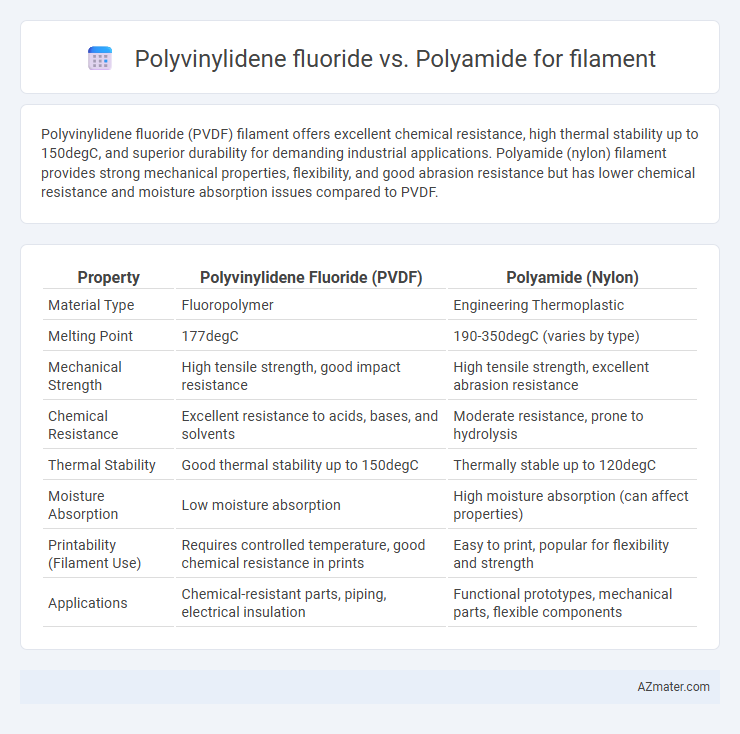Polyvinylidene fluoride (PVDF) filament offers excellent chemical resistance, high thermal stability up to 150degC, and superior durability for demanding industrial applications. Polyamide (nylon) filament provides strong mechanical properties, flexibility, and good abrasion resistance but has lower chemical resistance and moisture absorption issues compared to PVDF.
Table of Comparison
| Property | Polyvinylidene Fluoride (PVDF) | Polyamide (Nylon) |
|---|---|---|
| Material Type | Fluoropolymer | Engineering Thermoplastic |
| Melting Point | 177degC | 190-350degC (varies by type) |
| Mechanical Strength | High tensile strength, good impact resistance | High tensile strength, excellent abrasion resistance |
| Chemical Resistance | Excellent resistance to acids, bases, and solvents | Moderate resistance, prone to hydrolysis |
| Thermal Stability | Good thermal stability up to 150degC | Thermally stable up to 120degC |
| Moisture Absorption | Low moisture absorption | High moisture absorption (can affect properties) |
| Printability (Filament Use) | Requires controlled temperature, good chemical resistance in prints | Easy to print, popular for flexibility and strength |
| Applications | Chemical-resistant parts, piping, electrical insulation | Functional prototypes, mechanical parts, flexible components |
Introduction to 3D Printing Filament Materials
Polyvinylidene fluoride (PVDF) offers excellent chemical resistance, high thermal stability, and strong mechanical properties, making it ideal for advanced 3D printing applications requiring durability and resistance to harsh environments. Polyamide (PA), commonly known as nylon, provides superior flexibility, toughness, and impact resistance, widely favored in functional prototyping and end-use parts due to its ease of printing and good layer adhesion. When selecting 3D printing filaments, understanding the material properties of PVDF and PA helps optimize print quality and performance tailored to specific application needs.
Overview of Polyvinylidene Fluoride (PVDF)
Polyvinylidene fluoride (PVDF) is a high-performance thermoplastic known for exceptional chemical resistance, mechanical strength, and thermal stability, making it ideal for specialized filament applications in 3D printing and industrial manufacturing. PVDF exhibits excellent resistance to solvents, acids, and UV radiation, outperforming polyamide in durability under harsh environmental conditions. Its high melting point around 177degC supports high-temperature processing, while maintaining flexibility and impact resistance crucial for precision engineering components.
Overview of Polyamide (Nylon)
Polyamide (Nylon) filament offers excellent tensile strength, flexibility, and impact resistance, making it ideal for functional prototyping and engineering applications. It features good chemical resistance and low friction properties, suitable for gears, bearings, and structural components. Compared to Polyvinylidene fluoride (PVDF), Nylon provides higher toughness and abrasion resistance but has lower chemical and UV resistance.
Mechanical Properties Comparison
Polyvinylidene fluoride (PVDF) filament exhibits superior chemical resistance, high tensile strength around 48 MPa, and excellent fatigue resistance, making it ideal for demanding mechanical applications. Polyamide (Nylon) filament offers high impact resistance, with tensile strength typically between 50-70 MPa, and excellent flexibility, but lower chemical stability compared to PVDF. PVDF stands out for applications requiring durability in harsh chemical environments, while polyamide excels in toughness and wear resistance under mechanical stress.
Chemical Resistance and Durability
Polyvinylidene fluoride (PVDF) exhibits superior chemical resistance, withstanding strong acids, bases, and solvents, making it ideal for harsh environments compared to polyamide, which is more susceptible to hydrolysis and chemical degradation. PVDF also offers excellent durability with high mechanical strength, UV stability, and resistance to abrasion, whereas polyamide, while tough, degrades faster under prolonged chemical exposure and moisture. This makes PVDF filaments preferable for applications requiring long-term chemical resistance and environmental endurance.
Printability and Processing Characteristics
Polyvinylidene fluoride (PVDF) filament offers superior chemical resistance and high thermal stability, making it ideal for applications requiring durability and exposure to harsh environments, while its printability benefits from a moderate melting point and low warping tendencies. Polyamide (nylon) filament excels in flexibility, high tensile strength, and impact resistance but typically demands precise moisture control and higher extrusion temperatures, which can complicate processing and increase the risk of warping or layer adhesion issues. PVDF's lower shrinkage rates and better dimensional stability during printing contrast with polyamide's tendency to absorb moisture, necessitating thorough drying to maintain optimal print quality and mechanical performance.
Applications in 3D Printing
Polyvinylidene fluoride (PVDF) filament is prized in 3D printing for its exceptional chemical resistance, mechanical strength, and thermal stability, making it ideal for producing components in the chemical, automotive, and aerospace industries. Polyamide (Nylon) filament offers superior flexibility, durability, and impact resistance, commonly used for functional prototypes, gears, and wearable devices requiring high toughness and abrasion resistance. PVDF suits applications demanding high chemical inertness and dimensional stability, while Polyamide excels in parts subjected to mechanical stress and wear.
Cost and Availability Analysis
Polyvinylidene fluoride (PVDF) filaments generally exhibit higher costs due to their chemical resistance and specialized production processes, making them less widely available compared to polyamide (PA) filaments. Polyamide filaments, such as Nylon, benefit from established supply chains and mass production, resulting in lower prices and greater availability in the 3D printing market. Cost-sensitive applications favor polyamide for its affordability and accessibility, while PVDF is chosen for niche uses requiring enhanced durability despite the premium price.
Environmental Impact and Sustainability
Polyvinylidene fluoride (PVDF) filaments are valued for their chemical resistance and durability but pose environmental challenges due to their non-biodegradable nature and complex recycling processes. Polyamide (nylon) filaments, while offering good mechanical properties and flexibility, have a relatively lower environmental footprint as they can be recycled and some variants are partially biodegradable. Comparing sustainability, polyamide filaments generally offer better eco-friendly advantages through lower energy consumption in production and improved end-of-life recyclability than PVDF.
Conclusion: Choosing the Optimal Filament for Your Needs
Polyvinylidene fluoride (PVDF) offers superior chemical resistance, thermal stability, and UV resistance, making it ideal for applications requiring durability in harsh environments. Polyamide (Nylon) provides excellent mechanical strength, flexibility, and abrasion resistance, suitable for functional prototypes and end-use parts requiring toughness. Selecting the optimal filament depends on specific use cases: PVDF excels in chemically demanding conditions, while Polyamide is preferred for mechanical performance and flexibility.

Infographic: Polyvinylidene fluoride vs Polyamide for Filament
 azmater.com
azmater.com